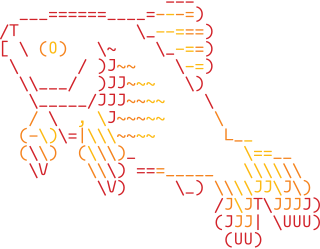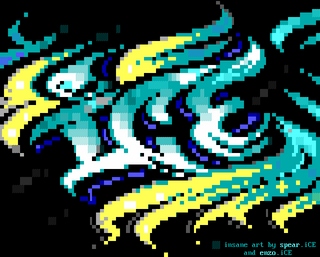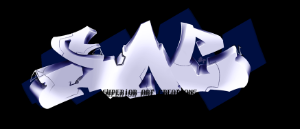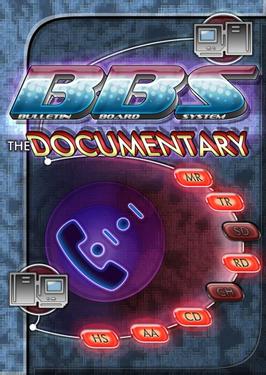
ASCII art is a graphic design technique that uses computers for presentation and consists of pictures pieced together from the 95 printable characters defined by the ASCII Standard from 1963 and ASCII compliant character sets with proprietary extended characters. The term is also loosely used to refer to text-based visual art in general. ASCII art can be created with any text editor, and is often used with free-form languages. Most examples of ASCII art require a fixed-width font such as Courier for presentation.

A storyboard is a graphic organizer that consists of illustrations or images displayed in sequence for the purpose of pre-visualizing a motion picture, animation, motion graphic, or interactive media sequence. The storyboarding process, in the form it is known today, was developed at Walt Disney Productions during the early 1930s, after several years of similar processes being in use at Walt Disney and other animation studios.

The demoscene is an international computer art subculture focused on producing demos: self-contained, sometimes extremely small, computer programs that produce audiovisual presentations. The purpose of a demo is to show off programming, visual art, and musical skills. Demos and other demoscene productions are shared, voted on and released online at festivals known as demoparties.
The computer art scene, or simply artscene, is the community interested and active in the creation of computer-based artwork.
An acid is any chemical compound that, when dissolved in water, gives a solution with a pH of less than 7.0.
ACiD Productions (ACiD) is a digital art group. Founded in 1990, the group originally specialized in ANSI artwork for bulletin board systems (BBS). More recently, they have extended their reach into other graphical media and computer software development. During the BBS-era, their biggest competitor was iCE Advertisements.
Christian Wirth, better known by the pseudonym RaD Man, is an American computer artist and historian. He works in the field of ANSI art, a method of creating art using a limited set of text characters and color escape codes based loosely on the relevant ANSI standard.
ANSI art is a computer art form that was widely used at one time on bulletin board systems. It is similar to ASCII art, but constructed from a larger set of 256 letters, numbers, and symbols — all codes found in IBM code page 437, often referred to as extended ASCII and used in MS-DOS and Unix environments. ANSI art also contains special ANSI escape sequences that color text with the 16 foreground and 8 background colours offered by ANSI.SYS, an MS-DOS device driver loosely based upon the ANSI X3.64 standard for text terminals. Some ANSI artists take advantage of the cursor control sequences within ANSI X3.64 in order to create animations, commonly referred to as ANSImations. ANSI art and text files which incorporate ANSI codes carry the de facto.ANS file extension.

iCE Advertisements is a digital art group founded in Canada by Many Axe in 1991. Although the expanded title is rarely ever used, iCE is an acronym for Insane Creators Enterprise. iCE, along with ACiD Productions, was one of the most prominent and critically successful groups on the underground computer artscene.

Superior Art Creations (SAC) is an underground artscene group which caters primarily to and is well known within the warez scene. SAC members have made, besides ANSI and ASCII art, VGA bitmap graphics, tracker music, and a variety of other works. SAC's character graphics have also been used in bottles and FTP servers.

The Warez scene, often referred to as The Scene, is an underground network of piracy groups specialized in obtaining and illegally releasing digital media before their official release date. The Scene distributes all forms of digital media, including computer games, movies, TV shows, music, and pornography. This network is meant to be hidden from the public, with the files shared only with members of the community. However, as files became commonly leaked outside the community and their popularity grew, some individuals from The Scene began leaking files and uploading them to file-hosts, torrents and EDonkey Networks.

BBS: The Documentary is a 3-disc, 8-episode documentary about the subculture born from the creation of the bulletin board system (BBS) filmed by computer historian Jason Scott of textfiles.com.

Soulz at Zero (SAZ) was a lit group formed in 1994 by Jack Flack and The Stranger. SAZ released 25 monthly packs over a period of two years, beginning in September 1994 and ending in September 1996. The group took its name from a Souls at Zero poster Flack had in his bedroom at the time, with the trailing "s" in "Souls" changed to a "z". Soulz at Zero was so well known that their name was added to the "Elite Acronym List," which was used to separate "lamers" from "elite users."

Creators of Intense Art, or Cia was an underground computer artscene group that primarily released ANSI, ASCII, and high resolution artwork from 1993 to 2001. Along with iCE and ACiD, Cia was one of the most active, and longest lasting groups on the artscene.
Digital Artists of a Rare Kind, later known as Dark Illustrated, or simply Dark was an underground computer artscene group that primarily released ANSI, ASCII, and high resolution artwork from 1994 to 1999. Though the organization did not operate as long as ACiD, iCE, or CiA, Dark was a very influential and critically successful group. Dark was especially popular with Canadian ANSI artists, who made up a large portion of the member base.
Blade, also referred to as The Blade Nation, was an underground computer artscene group that primarily released ANSI, ASCII, and high resolution artwork from 1994 to 1997, and during a brief time in 1998.

Fire, later known as Fire Graphics, is an underground computer artscene group that released ANSI, ASCII, and high resolution artwork from 1994 to 1998, and from 2021 onwards.
This is a list of the minor computer underground artscene groups spanning from roughly 1992 to the present day.

Acid house is a subgenre of house music developed around the mid-1980s by DJs from Chicago. The style is defined primarily by the squelching sounds and basslines of the Roland TB-303 electronic bass synthesizer-sequencer, an innovation attributed to Chicago artists Phuture and Sleezy D circa 1986.
Aces of ANSI Art was the first group of artists specifically organized for the purposes of creating and distributing ANSI art. The group was founded and operated by two BBS enthusiasts from California, "Zyphril" and "Chips Ahoy", from 1989 through 1991.